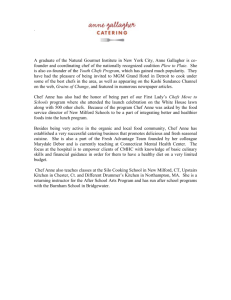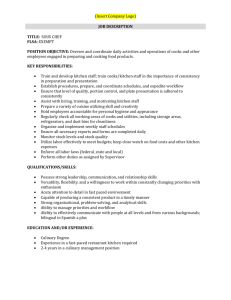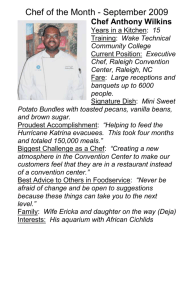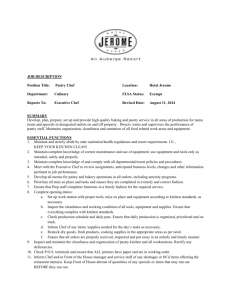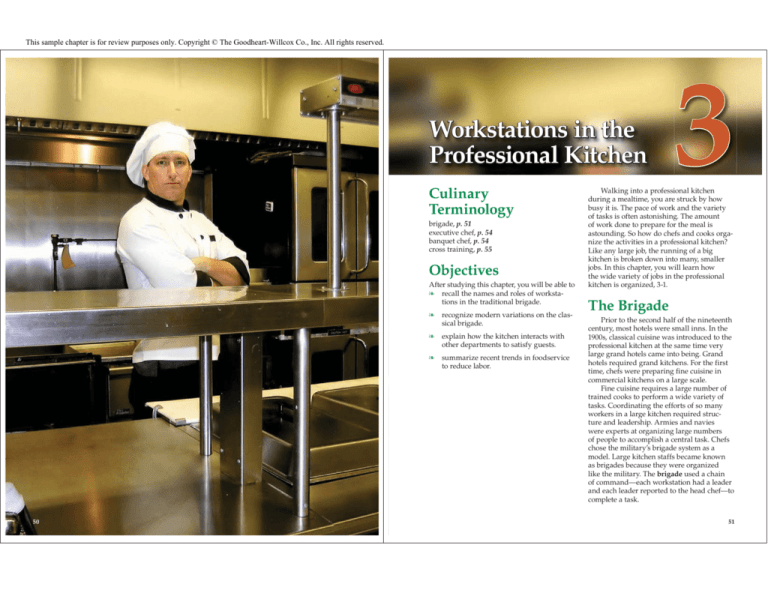
This sample chapter is for review purposes only. Copyright © The Goodheart-Willcox Co., Inc. All rights reserved.
Workstations in the
Professional Kitchen
Culinary
Terminology
brigade, p. 51
executive chef, p. 54
banquet chef, p. 54
cross training, p. 55
Objectives
After studying this chapter, you will be able to
❧ recall the names and roles of workstations in the traditional brigade.
❧ recognize modern variations on the classical brigade.
❧ explain how the kitchen interacts with
other departments to satisfy guests.
❧ summarize recent trends in foodservice
to reduce labor.
50
3
Walking into a professional kitchen
during a mealtime, you are struck by how
busy it is. The pace of work and the variety
of tasks is often astonishing. The amount
of work done to prepare for the meal is
astounding. So how do chefs and cooks organize the activities in a professional kitchen?
Like any large job, the running of a big
kitchen is broken down into many, smaller
jobs. In this chapter, you will learn how
the wide variety of jobs in the professional
kitchen is organized, 3-1.
The Brigade
Prior to the second half of the nineteenth
century, most hotels were small inns. In the
1900s, classical cuisine was introduced to the
professional kitchen at the same time very
large grand hotels came into being. Grand
hotels required grand kitchens. For the first
time, chefs were preparing fine cuisine in
commercial kitchens on a large scale.
Fine cuisine requires a large number of
trained cooks to perform a wide variety of
tasks. Coordinating the efforts of so many
workers in a large kitchen required structure and leadership. Armies and navies
were experts at organizing large numbers
of people to accomplish a central task. Chefs
chose the military’s brigade system as a
model. Large kitchen staffs became known
as brigades because they were organized
like the military. The brigade used a chain
of command—each workstation had a leader
and each leader reported to the head chef—to
complete a task.
51
Chapter 3 Workstations in the Professional Kitchen 53
52 Part 1 Introducing the Foodservice Industry
In the brigade system, similar tasks and
products were assigned by station. Most
modern kitchens don’t employ all the stations
of a classical brigade. However, the traditional
names are often used for specific jobs in the
kitchen, 3-2.
A hierarchical organization typical of the
traditional brigade is still used in many large
kitchens, 3-3.
Organization of
Modern Kitchens
3-1 A large kitchen operation must be well organized
to be successful.
One hundred years ago, larger staffs
were needed to work kitchens than are
needed today. Fewer cooks are needed to
staff today’s smaller operations equipped
with modern conveniences and more limited
menus. Despite the reduced staff size, a chain
of command and the organization of tasks by
stations still exist.
Brigade System
Workstation Positions
Duties
Garde manger
(gahrd mohn-ZHAY)
The garde manger is in charge of the cold food station. This position makes
salads, dressing, fruit plates, and many types of cold appetizers and buffet
platters.
Butcher
The butcher cuts and trims meats and poultry for other stations in the kitchen.
Rotisseur
(roh-teess-UHR)
This position is charged with roasting meats and poultry and preparing pan sauces
or gravies to accompany them. The rotisseur also carves these roasted items.
Grill cook
All grilled and broiled meats, poultry, and fish are cooked by this staff member.
Fry cook
Deep-fried items are prepared and cooked by the fry cook. Since grilled items
often have deep-fried garnishes, some kitchens combine the jobs of grill cook and
fry cook.
Entremetier
(ehn-treh-meh-tee YAY)
The entremetier oversees the preparation and cooking of vegetables, starches,
egg dishes, and hot appetizers.
Potager
(poh-tahj-AY)
The potager makes all stocks, soups, and mother sauces.
Légumier
(lay-goo-mee-YAY)
The légumier prepares and cooks vegetables. In some kitchens, the tasks of the
potager and légumier are combined and known as the preparation station.
Pastry chef
The pastry chef is the head of the baking and pastry department. He or she
oversees the work of specialists in that station.
Pastry cook
Pastry cooks prepare primarily sweets and pastries. These cooks work in the
bakeshop during the daytime.
Baker
The baker makes breads. Duties of a baker may also include breakfast pastries.
Bakers typically work during the night and early morning hours so breads are fresh
for the beginning of the workday.
Decorator
Many bakeshops have a specialist who decorates cakes and pastries. The
decorator also makes chocolate carvings or sugar sculptures for pastry displays.
This job requires artistic ability.
Tournant
(toor-NAHN)
The tournant is also called the swing chef or roundsman. This position fills in
for other staff members on their days off. A versatile and talented individual is
required to perform a different job each day.
Commis
(koh MEE)
In addition to cooks, a department may also have one or more commis (koh MEE)
or “assistants.”
Communard
(com-muh-NAHR)
In large operations, one person is assigned the task of preparing meals for the
staff. This position is referred to as the communard.
Expeditor
In restaurants, the expeditor reads the servers’ food orders to the cooks. This
position then organizes the finished dishes so servers can deliver them promptly.
Brigade System
Workstation Positions
Duties
Chef de cuisine
(shef deh kwih-ZEEN)
Chef de cuisine literally means “chief of the kitchen.” The chef supervises all the
positions in the kitchen. He or she is responsible for the quality of the food and the
safety of the guests and cooks.
Sous chef
(SOO shef)
Sous means “under” in French. The sous chef is the second in command. In the
absence of the chef, the sous chef assumes the authority and responsibility of the
chef.
Chef de garde
(shef deh GAHRD)
Chef de garde is the night chef. In a large operation that operates 24 hours a day,
the chef de garde is in charge of the kitchen after the chef has left for the evening.
Chef de partie
(shef deh pahr-TEE)
A chef de partie is the position in charge of any of the particular workstations in the
kitchen. In American kitchens, the chef de partie may be called a station chef. The
number of cooks working in each station varies with the size of the kitchen and
scope of the menu.
Saucier
(saw-see-YAY)
As the name of the position implies, the saucier is responsible for making sauces.
The saucier also prepares any sautéed or panfried items.
Poissonier
(pwah-sawn-YAY)
Poisson is French for “fish,” therefore the poissonier is the fish cook. This position
is responsible for the preparation of all fish and shellfish items. In many kitchens,
the poissonier is not under the direction of the saucier, but is the head of his or her
own workstation.
3-2 This chart describes the workstations that may be seen in large operations today.
3-2 Continued.
Chapter 3 Workstations in the Professional Kitchen 55
54 Part 1 Introducing the Foodservice Industry
The Classical Brigade
Chef
(Chef de Cuisine)
Chef de Garde
Sous Chef
Communard
Chefs de Partie
Tournant
Saucier
Garde Manger
Rotisseur
Entremetier
Pasty Chef
Poissonier
Butcher
Grill Cook
Potager
Pastry Cook
1st Commis
Commis
Fry Cook
Légumier
Baker
Commis
Commis
Decorator
2nd Commis
performed one specific job and became
expert at it. This narrow focus made very
intricate food preparations possible. It also
made labor hard to manage. What happens
when the expert fish cook is out sick? Who
works their position?
Cross training became popular because it
solved this problem. Cross training teaches
staff to do more than one job in the kitchen.
Scheduling staff is easier when employees are
cross trained. The chef has more flexibility
in assigning jobs. If a cook is sick or quits,
another employee can perform his or her job.
Cross training also eases the boredom associated with performing the same task every day.
Some restaurants take the concept of
crossing training one step further. These businesses cross train employees to do all the jobs
in the restaurant. This type of cross training
has restaurant staff cooking, serving guests,
or cashiering with equal ease.
Working with
Departments Beyond
the Kitchen
Foodservice operations in large restaurants, hotels, clubs, and resorts are complex.
The kitchen must work with other departments to be successful. Efforts must be
coordinated between the kitchen and the
stewarding, dining room, catering, room
service, and purchasing departments.
Stewarding
The stewarding department’s primary
task is sanitation. Warewashing—the cleaning
of dishes, glasses, and serviceware—is done
by this department. They also wash pots and
pans. This department is often responsible
for cleaning the kitchen as well. In addition
Industry Insights
Commis
3-3 The organizational chart of a classical brigade illustrates the department is ordered.
A foodservice operation’s menu is the
most important factor for determining the
staff size and organization of a kitchen. A
seafood house requires a large fish station,
grill station, and fryer station. However, this
operation may have no need for a rotisseur.
On the other hand, a restaurant specializing
in steaks and prime rib of beef will have
large rotisseur and grill stations. This business may need little or no staff to prepare
fish.
Many large hotels and resorts operate a
number of restaurants. Each restaurant has
its own chef de cuisine and brigade. The
hotel or resort employs an executive chef to
coordinate the operation of the restaurants
and departments. Many of the duties of an
executive chef are managerial. However, an
executive chef must also be an excellent cook
in order to oversee the work of other cooks
and chefs. Successful executive chefs interact
often with all members of their team and
even periodically work alongside them.
Most hotels have a special department
that prepares banquets or meals for large
groups. This department is headed by the
banquet chef. The banquet chef oversees a
staff of cooks that prepare meals for large
groups.
Cross Training
The traditional way of organizing work
in kitchens created specialists. A cook
Teamwork in the Brigade
Luis, the banquet chef in a large private club,
is preparing for an upscale wedding banquet.
The hosts have chosen Beef Wellington for their
main course. Beef Wellington is a beef tenderloin
baked in pastry with mushrooms and liver pâté
served with a truffle sauce. Preparation of this dish
demonstrates how stations in a large kitchen must
work together.
Luis must work with other stations to
assemble components of this dish. After receiving
the menu for the party from the executive chef,
he sees the butcher to get the beef tenderloin
needed for the banquet. In the banquet kitchen,
the banquet cooks brown the tenderloins as the
first step in the preparation of the dish.
Luis sends one of his commis to the garde
manger chef to get several pounds of liver pâté.
The pâté will be stuffed into the middle of the
tenderloins. Luis also gets several pounds of
mushroom duxelle that was prepared by the
entremetier. The duxelle is spread over the surface
of the tenderloins.
Once the tenderloins are seared, stuffed,
and covered with mushroom duxelle, one of the
banquet staff takes them to the pastry department.
In the pastry department, one of the pastry cooks
wraps each tenderloin in puff pastry.
The saucier prepares Madeira sauce with
truffles and delivers it to the banquet kitchen. As
time for the banquet meal gets closer, the banquet
chef bakes the tenderloins. At service, Luis’ staff
slices the finished Beef Wellington and serves it
with the sauce. The meal is a success because
the brigade worked together as a team.
Chapter 3 Workstations in the Professional Kitchen 57
56 Part 1 Introducing the Foodservice Industry
to cleaning, people who work in stewarding
store, inventory, and transport serviceware.
Because many tasks in the stewarding
department require unskilled labor, its
importance is often overlooked. Yet, this
department is key to a good foodservice
operation. Imagine a cook trying to serve a
meal and there are no clean plates. Consider
the impact of a kitchen being shut down by a
health inspector due to poor sanitation. In all
foodservice operations, cleanliness is crucial.
Dining Room
No matter how good food tastes, if not
served properly the diner will not be satisfied.
The kitchen works closely with the dining
room to ensure that their carefully prepared
food is served to the guest in a pleasing
manner. Timing the cooking and serving of
food is the most critical interaction between
the kitchen and servers. If the food preparation
takes too long or the food is cold, guests will be
dissatisfied. Additionally, food must be served
correctly and with a friendly attitude, 3-4.
Catering
In large operations that do banquets and
catering, the sales staff and chefs must work
closely to plan events. Chefs are consulted to
create menus for large events. Communication
between the sales, kitchen, and service staffs
for large affairs is crucial to the success of
catered events. During an event, banquet chefs
consult often with the sales staff and servers
to discuss timing of the meal service and
special requests from guests.
Room Service
Larger hotels offer guests the option
of dining in their rooms. Special staff is
assigned to take room-service orders and
serve them in guests’ rooms. The food is
prepared in one of the hotel’s restaurants. In
some cases, the hotel has a separate kitchen
for room service. No matter where the food
is prepared, good communication and timing
between the kitchen and room-service staffs
are essential to please room-service diners.
Purchasing
Many large operations have staff whose
job is to purchase, receive, and store the food
and supplies used by foodservice. The chef
works closely with the purchasing staff to
ensure the right products and correct quantities are being purchased. The staff issues
food and supplies out of the storeroom to the
cooks as needed.
Labor Saving Trends
The size of the kitchen staff needed to
create fine cuisine in the 1900s is not in the
budget of a modern kitchen. If the same
number of staff were needed today, only the
wealthy would be able to afford fine cuisine.
Labor is one of the largest costs in the foodservice industry. The trend in foodservice
is to reduce labor costs. Chefs have been
successful using technology and prepared
foods to control labor costs. This trend will
undoubtedly continue.
Technology
3-4 The dining room staff works with the kitchen to satisfy guests.
Advances in the technology of foodservice equipment have made great labor
savings in the commercial kitchen possible.
Food processors and grinders allow one cook
to do the chopping and puréeing that used
to take many cooks to do by hand. Vegetable
cutting machines eliminate many hours of
knife work. Roll-in rack ovens allow one cook
to load and remove hundreds of portions
from the oven quickly and easily.
Some kitchens prepare entrées for the
entire week and vacuum-pack them in
special plastic bags. During service, one cook
can reheat and plate meals that used to take
several cooks to prepare.
Prepared Foods
Many prepared food products designed
to decrease labor in the kitchen are available
to chefs today. Though these products cost
more than the basic ingredients needed to
make the item, less labor is used. Labor can
be one of the largest costs for a foodservice
operation. The labor savings means lower
cost. The labor savings is usually greater than
the increased product cost. Prepared foods
also contribute to product consistency. Some
common labor-saving items in commercial
kitchens include the following:
❧ Portion-controlled meats and fish
❧ Precut vegetables
❧ Prepared sauces and soups
❧ Powdered soup base and sauce mixes
❧ Frozen precooked meats and vegetables
❧ Ready-made breads and pastries
Culinary Trends
Cooking Under
Vacuum
Vacuum packing has been used in
commercial food production since the 1960s.
Now sophisticated restaurant kitchens are
using this method also known as sous vide
(soo VEED). Sous vide is a technique that
combines fresh ingredients in vacuum-packed
pouches. These pouches are then cooked for
long periods of time at low temperatures. The
pouches are then cooled and stored for future
use. The vacuum packing seals in juices and the
extremely slow cooking tenderizes the product.
Sous vide is growing in popularity with chefs.
It gives them freedom to prepare food to their
specifications in advance and leave someone
else in charge at service time. The end result is
also very pleasing to diners as well. Due to the
long, slow-cooking technique, special health
and sanitary guidelines are often required.
Key Points
5. The _____ chef coordinates the operation
of restaurants and departments at hotels
and resorts.
❧ The kitchen brigade creates a chain of
leadership and responsibility.
6. What is an advantage of cross training?
❧ The professional kitchen is organized
into workstations to keep similar jobs
and food products together.
7. True or false. The stewarding department
purchases, receives, and stores food and
supplies for the operation.
❧ The staffing and number of stations is
determined by the menu and size of the
business.
8. Why is timing between the kitchen staff
and servers important?
❧ Cross training teaches staff to do more
than one job in the kitchen. This gives
the chef flexibility in assigning tasks.
❧ The kitchen brigade relies on other
departments in a foodservice operation,
like stewarding and dining room staff.
❧ Chefs use technology and prepared food
products to save labor and reduce kitchen
staff.
In Review
Write your answers on a separate sheet of paper.
1. Why did chefs use the military as a
model for organizing the work in their
kitchens?
2. What station takes charge of the kitchen
in the absence of the chef?
9. List four prepared food products that
decrease labor in the kitchen.
Thinking like a Chef
1. Compose. Some employees resist cross
training. Write a persuasive paper to
explain how cross training benefits them.
2. Consider. Managing labor cost is one
of a chef’s most important responsibilities. If a chef based his staffing decisions
only on saving labor cost, how might this
impact his operation?
3. Assess. Identify equipment and food
products that save labor hours in your
kitchen at home.
❧ Workplace Skills ❧
You have been hired as the chef de cuisine for a large hotel kitchen.
The manager who hired you told you there have been numerous
customer complaints about long waits for meals, spotted glassware
and flatware, and indifferent servers. What departments and positions would you meet with to resolve these issues? Explain.
❧ Chef’s Math ❧
By purchasing a commercial food processor, you will be able to
reduce labor spent processing vegetables every day. The food
processor costs $5,376. Currently, three cooks each work 8 hours per
day at a rate of $10.50 per hour. Only one cook will be needed to
work the food processor for 8 hours per day at $10.50 per hour. How
many days will it take before the cost of the food processor is paid
for in labor savings?
❧ Chef’s Lab ❧
Review a menu from your favorite restaurant. Based on the menu,
create a plan outlining the workstations you would use to organize
the kitchen staff.
3. List three responsibilities the saucier has.
4. Which station in the traditional brigade
would perform the following tasks?
A. Poach salmon filets.
B. Portion a loin into steaks.
C. Bake rye bread.
D. Clarify a broth for soup.
E. Cook dauphine potatoes.
F. Fill cream puffs with whipped
cream.
58
59


